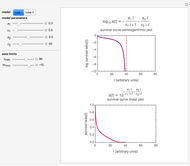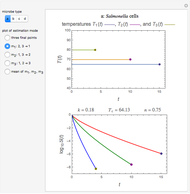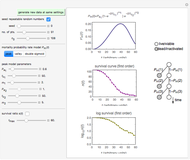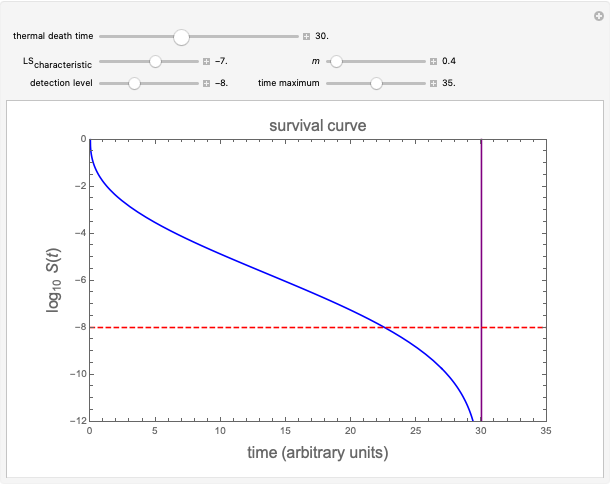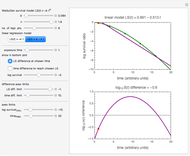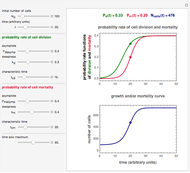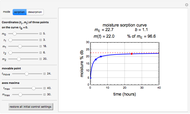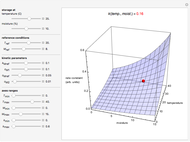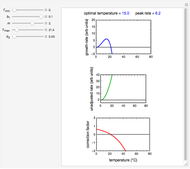Microbial Survival Curves with Asymptotic Residual

Requires a Wolfram Notebook System
Interact on desktop, mobile and cloud with the free Wolfram Player or other Wolfram Language products.
For technical reasons, the range of experimental microbial inactivation curves is usually limited to 6–8 decades reduction in the targeted microbe population. Therefore, at least in principle, marginal thermal or nonthermal antimicrobial treatments, especially of a microbe capable of adaptation, can result in unaccounted-for residual survival that would not be discovered by extrapolation of the survival curve using the log-linear or a power-law model. This Demonstration helps visualize such hypothetical scenarios in which the static semi-logarithmic survival curve above the detection level is approximately linear or has noticeable upward or downward concavity.
Contributed by: Micha Peleg and Mark D. Normand (January 2021)
Open content licensed under CC BY-NC-SA
Snapshots
Details
Snapshot 1: Simulated semi-logarithmic survival curve that appears to be following Weibull kinetics with a shape parameter  above the detection level. Note that at an extrapolated time to reach
above the detection level. Note that at an extrapolated time to reach  obtained by a power-law model, the actual survival ratio can be orders of magnitude higher.
obtained by a power-law model, the actual survival ratio can be orders of magnitude higher.
Snapshot 2: Simulated semi-logarithmic survival curve that appears to approximately follow first-order kinetics above the detection level. Note that at an extrapolated time to reach  obtained by the log-linear model, the actual survival ratio can be orders of magnitude higher.
obtained by the log-linear model, the actual survival ratio can be orders of magnitude higher.
Snapshot 3: Simulated semi-logarithmic survival curve appears to be following Weibull kinetics with a shape parameter  ("tailing") above the detection level. Note that at least superficially, the two models render similar survival curves.
("tailing") above the detection level. Note that at least superficially, the two models render similar survival curves.
Current microbial counting methods limit experimental survival curves to 6–8 decades reduction in the targeted microbial population's size. Therefore, at least theoretically, residual survival can remain concealed in log-linear or power-law models constructed from data above the detection level [1].
This Demonstration helps visualize such hypothetical scenarios with a model that, unlike the traditional log-linear or Weibull power-law model, has an asymptotic residual survival ratio in its formulation.
This model has the stretched exponential form  , where
, where  is the momentary survival ratio;
is the momentary survival ratio;  is the asymptotic residual survival ratio, marked by a solid purple horizontal line;
is the asymptotic residual survival ratio, marked by a solid purple horizontal line;  is a characteristic time and
is a characteristic time and  is a shape parameter.
is a shape parameter.
Where  , the initial part of the survival curve has clear upward concavity and where
, the initial part of the survival curve has clear upward concavity and where  , downward concavity. Where
, downward concavity. Where  , the initial part of the curve may appear linear (especially if the actual experimental data has some scatter).
, the initial part of the curve may appear linear (especially if the actual experimental data has some scatter).
To generate a new semi-logarithmic survival curve, displayed as a solid blue curve, select  for the model, displayed as a solid purple horizontal line; the
for the model, displayed as a solid purple horizontal line; the  and
and  values, as well as the detection level, displayed as a dashed red horizontal line; and time scale (time maximum) for the process, with their corresponding sliders.
values, as well as the detection level, displayed as a dashed red horizontal line; and time scale (time maximum) for the process, with their corresponding sliders.
Notice that not all the allowed parameter combinations in this Demonstration produce a survival curve that has a real-life counterpart.
Reference
[1] M. Peleg, Advanced Quantitative Microbiology for Foods and Biosystems: Models for Predicting Growth and Inactivation, Boca Raton: CRC Press, 2006.
Permanent Citation






